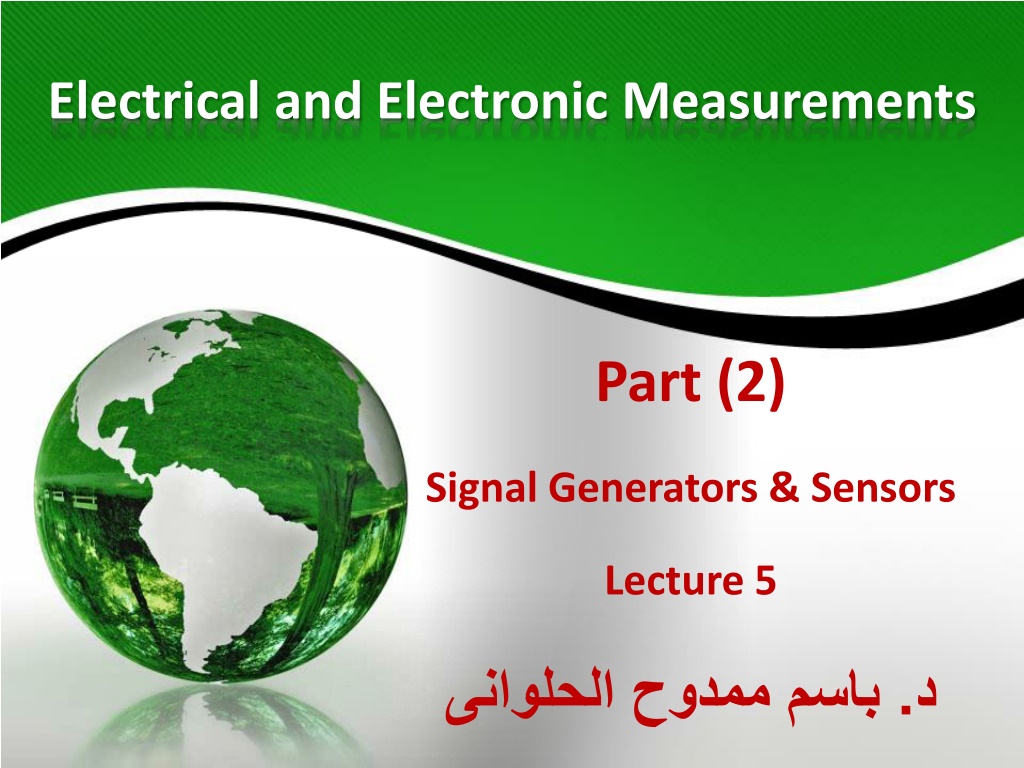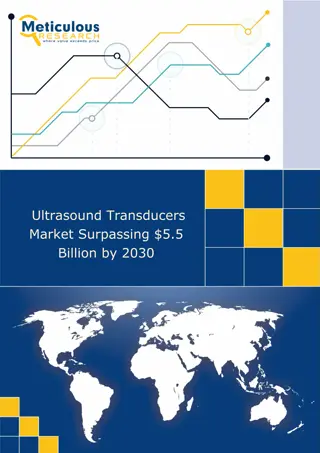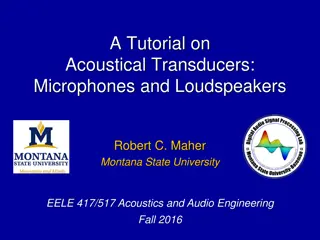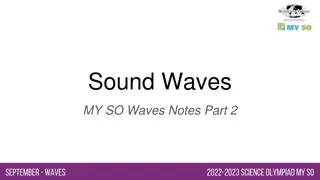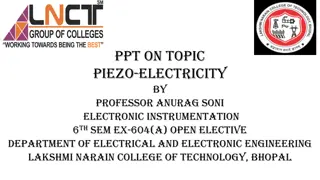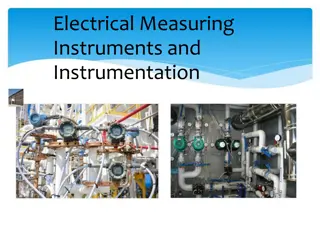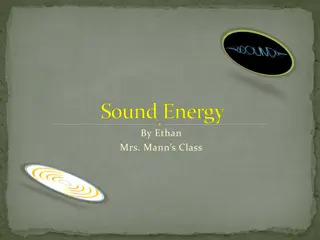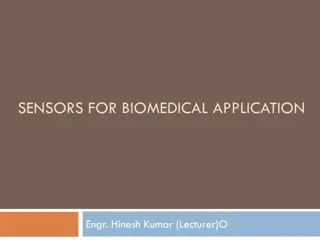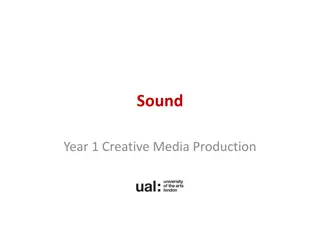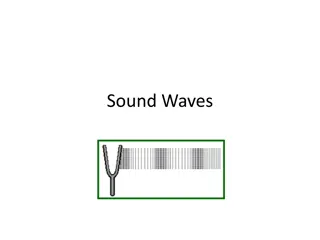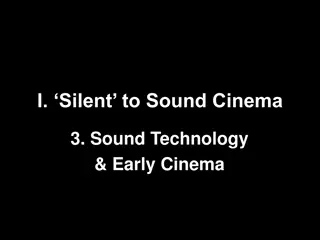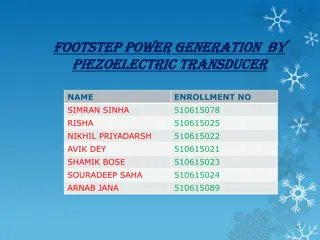Introduction to Sound Transducers in Electrical and Electronic Measurements
Sound transducers, such as microphones, play a crucial role in converting acoustic sound waves into electrical signals for measurement purposes. Different types of microphones, including dynamic moving-coil, condenser, and electret condenser, are discussed in this lecture. The operation principles and characteristics of these sound transducers are explored to understand their roles in signal generation and sensing applications.
Download Presentation

Please find below an Image/Link to download the presentation.
The content on the website is provided AS IS for your information and personal use only. It may not be sold, licensed, or shared on other websites without obtaining consent from the author. Download presentation by click this link. If you encounter any issues during the download, it is possible that the publisher has removed the file from their server.
E N D
Presentation Transcript
Electrical and Electronic Measurements Part (2) Signal Generators & Sensors Lecture 5 .
Introduction to Sensors & Transducers Sound Transducers Sound is the generalized name given to acoustic waves . Sound is basically a waveform of energy that is produced by some form of a mechanical vibration These acoustic waves have frequencies ranging from just 1Hz up to 20 kHz Sound requires a medium for transmission either through the air, a liquid, or a solid to be heard Microphone (mic) Input-type Sound Transducers (Sensor) convert sound into and electrical signal loudspeaker Output-type Sound Transducers (actuators) convert the electrical signals back into sound 2 Electrical & Electronics Measurements - Basem ElHalawany
Sound Transducers The Microphone Input Transducer it produces an electrical analog output signal which is proportional to the acoustic sound wave acting upon its flexible diaphragm. Many types are available such as Dynamic Moving-coil , condenser , Piezo- electric Crystal microphones 1. Dynamic Moving-coil Microphone Sound Transducer It has a very small coil of thin wire suspended within the magnetic field of a permanent magnet. As the sound wave hits the flexible diaphragm, the diaphragm moves back and forth in response to the sound pressure acting upon it This causes the attached coil of wire to move within the magnetic field of the magnet. The movement of the coil within the magnetic field causes a voltage to be induced in the coil as defined by Faraday s law The resultant output voltage signal from the coil is proportional to the pressure of the sound wave 3 Electrical & Electronics Measurements - Basem ElHalawany
Sound Transducers The Microphone Input Transducer 2. Condenser Microphone Condenser means capacitor, the term condenser is actually obsolete but has stuck as the name for this type of microphone. This Mic uses a capacitor to convert acoustical energy into electrical energy. It requires power from a battery or external source. The resulting audio signal is stronger signal than that from a dynamic. Condensers also tend to be more sensitive and responsive than dynamics, One of these plates is made of very light material and acts as the diaphragm. The diaphragm vibrates when struck by sound waves, changing the distance between the two plates and therefore changing the capacitance 4 Electrical & Electronics Measurements - Basem ElHalawany
Sound Transducers The Microphone Input Transducer 3. Electret Condenser Microphone The electret condenser mic uses a special type of capacitor which has a permanent voltage built in during manufacture. This is somewhat like a permanent magnet, in that it doesn't require any external power for operation. An electret microphone is an omnidirectional microphone, which means it can capture sound from all directions. 5 Electrical & Electronics Measurements - Basem ElHalawany
Sound Transducers The Loudspeaker Output Transducer Its job is to convert complex electrical analogue signals into sound waves being as close to the original input signal as possible. Loudspeakers are available in all shapes, sizes and frequency ranges with the more common types being moving coil, electrostatic, isodynamic and piezoelectric. Moving Coil Loudspeaker : The principle of operation of the Moving Coil Loudspeaker is the exact opposite to that of the Dynamic Microphone A coil of fine wire, called the speech or voice coil , is suspended within a very strong magnetic field, and is attached to a paper or Mylar cone, called a diaphragm which itself is suspended at its edges to a metal frame or chassis. When an signal passes through the voice coil, an electro-magnetic field is produced which opposes the main permanent magnetic field around it and tries to push the coil in one direction or the other. Since the coil is attached to the cone/diaphragm, the movement causes a disturbance in the air around it thus producing a sound 6
Proximity Sensors Proximity sensors detect the presence or absence of objects using electromagnetic fields, light, and sound. There are many types, each suited to specific applications and environments. Types of proximity sensors 1. Non-Contact Sensors : Optical Ultrasonic Inductive Capacitive 2. Contact Sensors (Mechanical) 7
Proximity Sensors 1. Optical (Photoelectric) proximity Sensors Photoelectric sensors are so versatile that they solve the bulk of problems All photoelectric sensors consist of a few of basic components: An emitter light source (Light Emitting Diode, Infra-red LED, laser diode), A photodiode or phototransistor receiver to detect emitted light, and Supporting electronics designed to amplify the receiver signal. Photoelectric proximity Sensors Configurations: 1. Through-beam 2. Retro-reflective 3. Diffuse 8
Optical sensors (Through-beam) Transmitter Receiver
Optical sensors (Through-beam) Transmitter Receiver
Optical sensors (Through-beam) Target Transmitter Receiver
Optical sensors (Through-beam) Transmitter Receiver
Optical sensors (Through-beam) Transmitter Receiver
Optical sensors (Through-beam) Transmitter Receiver
Optical sensors (Through-beam) Transmitter Receiver
Optical sensors (Through-beam) Transmitter Receiver
Optical sensors (Through-beam) Transmitter Receiver
Optical sensors (Through-beam) Transmitter Receiver
Optical sensors (Through-beam) Target Transmitter Receiver Long sensing distance: up to 30 metres with some devices Will detect all but very transparent materials Must be accurately aligned
Optical sensors (Retro-reflective) Type : Retro reflective T Transmitter /Receiver R Reflector (prismatic)
Optical sensors (Retro-reflective) Type : Retro reflective T Transmitter /Receiver R Reflector (prismatic)
Optical sensors (Retro-reflective) Type : Retro reflective T Transmitter /Receiver R Reflector (prismatic)
Optical sensors (Retro-reflective) Type : Retro reflective Target T Transmitter /Receiver R Reflector (prismatic)
Optical sensors (Retro-reflective) Type : Retro reflective T Transmitter /Receiver R Reflector (prismatic)
Optical sensors (Retro-reflective) Type : Retro reflective T Transmitter /Receiver R Reflector (prismatic)
Optical sensors (Retro-reflective) Type : Retro reflective T Transmitter /Receiver R Reflector (prismatic)
Optical sensors (Retro-reflective) Type : Retro reflective T Transmitter /Receiver R Reflector (prismatic)
Optical sensors (Retro-reflective) Type : Retro reflective T Transmitter /Receiver R Reflector (prismatic)
Optical sensors (Retro-reflective) Type : Retro reflective T Transmitter /Receiver R Reflector (prismatic)
Optical sensors (Retro-reflective) Type : Retro reflective T Transmitter /Receiver R Reflector (prismatic) Sensing distance : 1/2 to 1/3 of through-beam type Not suitable for reflective or transparent targets
Optical sensors (Diffuse) Target Type : Diffuse T Transmitter /Receiver R
Optical sensors (Diffuse) Type : Diffuse T Transmitter /Receiver R
Optical sensors (Diffuse) Type : Diffuse T Transmitter /Receiver R
Optical sensors (Diffuse) Type : Diffuse T Transmitter /Receiver R
Optical sensors (Diffuse) Type : Diffuse T Transmitter /Receiver R
Optical sensors (Diffuse) Type : Diffuse T Transmitter /Receiver R
Optical sensors (Diffuse) Type : Diffuse T Transmitter /Receiver R Sensing distance: much less than reflex type, actual distance depends on colour and reflective nature of the surface Larger targets result in longer sensing distances Not suitable for dirty environments
Non-contact Proximity sensors Inductive proximity sensor Capacitive proximity sensor C2 C1 P S C3 Capacitance increases as metal object (P) gets closer because additional capacitance paths C2 & C3 are added and increase in value as the separation reduces. C1 is always present. Coil inductance increases as iron / steel object (S ) gets closer 39
Non-contact Proximity sensors Ultrasonic (Sonar) sensors Ultrasonic sensor utilize the reflection of high frequency (20KHz) sound waves to detect parts or distances to the parts. In general, ultrasonic sensors are the best choice for transparent targets. They can detect a sheet of transparent plastic film as easily as a wooden pallet. Different Colors has no effect The most common configurations are the same as in photoelectric sensing: through beam, retro-reflective, and diffuse versions. 40
Non-contact Proximity sensors Ultrasonic (Sonar) versus IR sensors The primary difference is that sonar has a wide detection cone and longer range Unlike IR sensors, sonars are slightly harder to deal with when it comes to multiple sensors. Because of the wide cone, and how sound can reflect, they can interfere with each other quite easily. Typically, you must allow a 50ms between each firing of a sonar sensors, to let the ping die off. If you have multiple sensors, you can only ping one at a time, and must still obey this 50ms ring down time or have each sonar operating at a different sound frequency 41
